
A sugar beet is a plant whose root contains a high concentration of sucrose and which is grown commercially for sugar production. In plant breeding, it is known as the Altissima cultivar group of the common beet. Together with other beet cultivars, such as beetroot and chard, it belongs to the subspecies Beta vulgaris subsp. vulgaris but classified as var. saccharifera . Its closest wild relative is the sea beet.
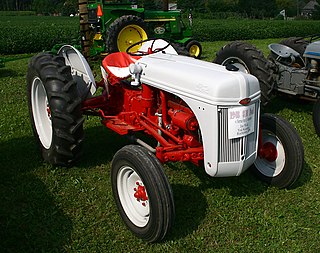
A tractor is an engineering vehicle specifically designed to deliver a high tractive effort at slow speeds, for the purposes of hauling a trailer or machinery such as that used in agriculture, mining or construction. Most commonly, the term is used to describe a farm vehicle that provides the power and traction to mechanize agricultural tasks, especially tillage, and now many more. Agricultural implements may be towed behind or mounted on the tractor, and the tractor may also provide a source of power if the implement is mechanised.

The modern combine harvester, also called a combine, is a machine designed to harvest a variety of cultivated seeds. Combine harvesters are one of the most economically important labour-saving inventions, significantly reducing the fraction of the population engaged in agriculture. Among the crops harvested with a combine are wheat, rice, oats, rye, barley, corn (maize), sorghum, millet, soybeans, flax (linseed), sunflowers and rapeseed. The separated straw is then either chopped onto the field and ploughed back in, or laid out in rows, ready to be baled and used for bedding and cattle feed.
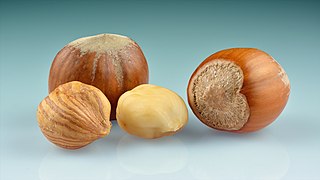
The hazelnut is the fruit of the hazel tree and therefore includes any of the nuts deriving from species of the genus Corylus, especially the nuts of the species Corylus avellana. They are also known as cobnuts or filberts according to species.

Deere & Company, doing business as John Deere, is an American corporation that manufactures agricultural machinery, heavy equipment, forestry machinery, diesel engines, drivetrains used in heavy equipment, and lawn care equipment. It also provides financial services and other related activities.

Fendt is a German agricultural machinery manufacturer founded in 1930 by Xaver Fendt in Marktoberdorf, Allgäu region, Germany. Fendt manufactures tractors, combine harvesters, balers, telescopic handlers and row crop planters. It was purchased by AGCO Corporation in 1997.
A cotton picker is either a machine that harvests cotton, or a person who picks ripe cotton fibre from the plants. The machine is also referred to as a cotton harvester.
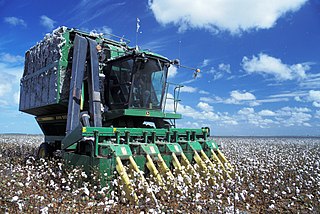
Mechanised agriculture or agricultural mechanization is the use of machinery and equipment, ranging from simple and basic hand tools to more sophisticated, motorized equipment and machinery, to perform agricultural operations. In modern times, powered machinery has replaced many farm task formerly carried out by manual labour or by working animals such as oxen, horses and mules.
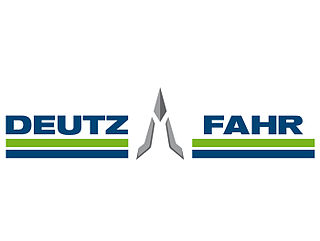
Deutz-Fahr is a German agricultural machinery manufacturer. It was established in 1968 after the acquisition of the majority of share capital in FAHR, a leading company already producing agricultural equipment in the previous century, by the Klöckner-Humboldt-Deutz AG (KHD) group. In 1995 Deutz-Fahr joined the Italian Group SAME/Lamborghini/Hürlimann to become the SAME Deutz-Fahr Group, now the SDF Group.
New Holland is a global full-line agricultural machinery manufacturer founded in New Holland, Pennsylvania, and now based in Turin, Italy. New Holland's products include tractors, combine harvesters, balers, forage harvesters, self-propelled sprayers, haying tools, seeding equipment, hobby tractors, utility vehicles and implements, and grape harvesters. Originally formed as the New Holland Machine Company in 1895, the company is now owned by CNH Industrial N. V., a company incorporated in the Netherlands.

CLAAS is an agricultural machinery manufacturer based in Harsewinkel, Germany, in the federal state of North Rhine Westphalia. Founded in 1913 by August Claas, CLAAS is a family business and one of the market and technology leaders in harvesting technology. It is the European market leader in combine harvesters and considered as world market leader in self-propelled forage harvesters. The product range also includes tractors, balers, mowers, rakes, tedders, silage trailers, wheel loaders, telehandlers and other harvesting equipment as well as farming information technology. CLAAS employs around 11,500 employees worldwide and reported a turnover of roughly 3.9 billion euros in the 2019 financial year. About 78.5% of sales are generated outside of Germany.

Two-wheel tractor or walking tractor are generic terms understood in the US and in parts of Europe to represent a single-axle tractor, which is a tractor with one axle, self-powered and self-propelled, which can pull and power various farm implements such as a trailer, cultivator or harrow, a plough, or various seeders and harvesters. The operator usually walks behind it or rides the implement being towed. Similar terms are mistakenly applied to the household rotary tiller or power tiller; although these may be wheeled and/or self-propelled, they are not tailored for towing implements. A two-wheeled tractor specializes in pulling any of numerous types of implements, whereas rotary tillers specialize in soil tillage with their dedicated digging tools. This article concerns two-wheeled tractors as distinguished from such tillers.
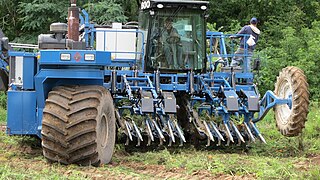
A Carrot Harvester is an agricultural machine for harvesting carrots. Carrot harvesters are either top lifters or share lifters and may be tractor mounted, trailed behind a tractor or self-propelled. The machine typically harvests between one and six rows of carrots at once.

The cultivation of tobacco usually takes place annually. The tobacco is germinated in cold frames or hotbeds and then transplanted to the field until it matures. It is grown in warm climates with rich, well-drained soil. About 4.2 million hectares of tobacco were under cultivation worldwide in 2000, yielding over seven million tonnes of tobacco.
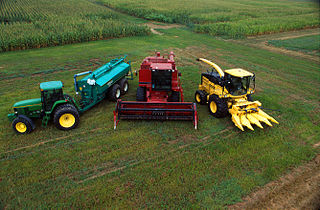
Agricultural machinery relates to the mechanical structures and devices used in farming or other agriculture. There are many types of such equipment, from hand tools and power tools to tractors and the countless kinds of farm implements that they tow or operate. Diverse arrays of equipment are used in both organic and nonorganic farming. Especially since the advent of mechanised agriculture, agricultural machinery is an indispensable part of how the world is fed. Agricultural machinery can be regarded as part of wider agricultural automation technologies, which includes the more advanced digital equipment and robotics. While agricultural robots have the potential to automate the three key steps involved in any agricultural operation, conventional motorized machinery is used principally to automate only the performing step where diagnosis and decision-making are conducted by humans based on observations and experience.
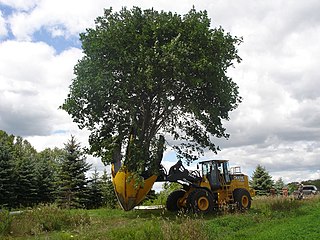
A tree spade is a specialized machine that mechanizes the transplanting of large plants whose hand-powered transplanting would be prohibitively laborious. These include large bushes and small or medium trees. By bringing mechanized power to what was formerly only a manual process, tree spades do for transplanting what tractors and combine harvesters do for agriculture, and what excavators and other heavy equipment do for construction. Today, tree spades are widely used in the tree nursery industry to increase production rates, and in the landscaping industry for tree removal and transplanting.
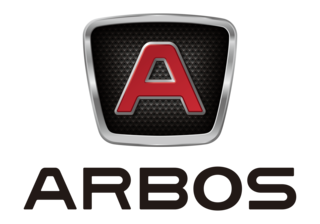
ARBOS is an Italian agricultural machinery company located in Migliarina di Carpi, Modena, Italy. It was founded in 1954 in Piacenza, Italy. ARBOS manufactures tractors, fertilizer equipment, seeding equipment and sprayers.
Potato harvesters are machines that harvest potatoes. They work by lifting the potatoes from the bed using a share. Soil and crop are transferred onto a series of webs where the loose soil is sieved out. The potatoes are moved towards the back of the harvester on to a separation unit and then to a picking table where people pick out the stones, clods, and haulms by hand. The potatoes then go on to a side elevator and into a trailer or a potato box.

The agricultural machinery industry or agricultural engineering industry is the part of the industry, that produces and maintain tractors, agricultural machinery and agricultural implements used in farming or other agriculture. This branch is considered to be part of the machinery industry.
















